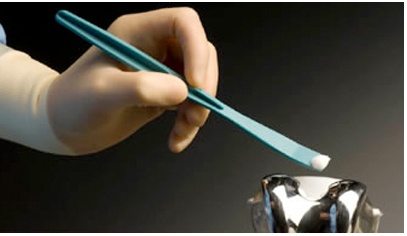At first glance, it seems like such a small component of total joint replacement…Bone Cement Removal. What’s the big deal? In a procedure that typically lasts two hours or more, the cement removal part is just a fraction of the time. Why the big concern? Because this seemingly simple task can have repercussions affecting the outcome of the procedure, the costs associated with the procedure and the longevity of the implant! The important message here is you have choices…you can easily take steps to avoid these situations.
The choices available are safe, convenient and economical. Take a look at the three reasons you will want to give this smarter choice a try.
Number 1: Precise bone cement removal is critical to procedure outcome!
As described in “Methods of Removing Excess Bone Cement”, excess bone cement is typically removed by various techniques including cutting, scraping, and “thumbing”.
While thumbing does effectively take care of removing the cement at the implant edge, it also produces a tapered shelf of excess cement that can produce loose flakes of PMMA material, with the potential for third body wear even leading to an early failure of the prosthesis. To avoid that, it is recommended that the excess tapered shelf be cut with the appropriate instruments in accessible and inaccessible areas to produce the most consistent surface, thereby removing the debris.
Number 2: Common methods of cement removal risk scratching the implant
Because the removal of bone cement is such a small part of the Total Joint Replacement procedure, often times no real strategy is employed when selecting a method or a tool for the method. Consequently, many surgeons use a more general purpose instrument that is immediately at hand during the procedure…something like a freer elevator or a metal curette.

As referenced in Modern Arthroscopy, edited by Dr. Jason L. Dragoo, extreme care must be used when trocars and other instruments are inserted or manipulated in the joint so as not to scratch the metal surface of the implant. This thinking is supported in The Journal of Bone and Joint Surgery in an article titled “Early metallosis-related failure after total knee replacement” where it is stated that metallosis can occur when the polyethylene surfaces of the implant have been worn away. Surgeons often use a metal freer or similar available instrument to remove excess bone cement during primary total joint replacements. To eliminate the possibility where the surface of the implant might be scratched, surgeons can use plastic, single use instruments designed for that purpose…cement removal without the risk of scratching the implant.
Number 3: Disposable single use curettes are economical for bone cement removal
Besides the obvious, that our patients’ safety is our primary concern, Surgical Site Infections are costly. SSIs are estimated to increase a patients stay in the hospital by 7 days at a cost of over $5,000. As a means of ensuring this doesn’t happen, it is paramount that instruments are sterile, and with disposable instruments the chances of something going wrong, i.e. an instrument becoming infected, or non-sterilized, is much lower.
Add to that the economic reality that if you spend more than 10 minutes of staff time cleaning cured cement from instruments, transferring and tracking tools through to sterile processing and re-sterilizing, re-stocking and maintenance of inventory, you have already exceeded the cost of a single-use bone cement curette.
Conclusion: The No-Scratch™ Whitney Curette™ is a tool that can be used in the effort to keep patient’s safe during surgical procedures. In addition, it protects the implant from scratches that can lead to improper functioning of the implant which in turn leads to the need for a surgical revision. And, it is economical…saving money by not contributing to SSIs and by saving staff and operating room time.

